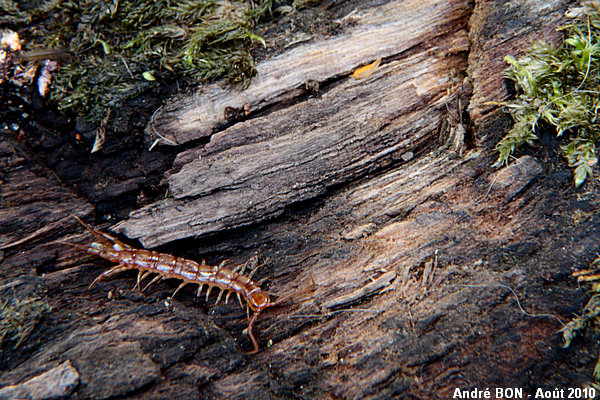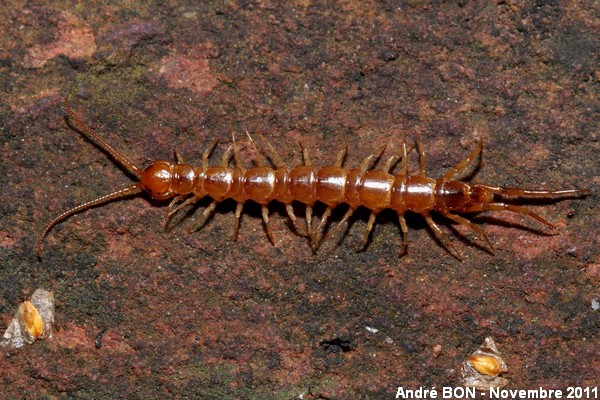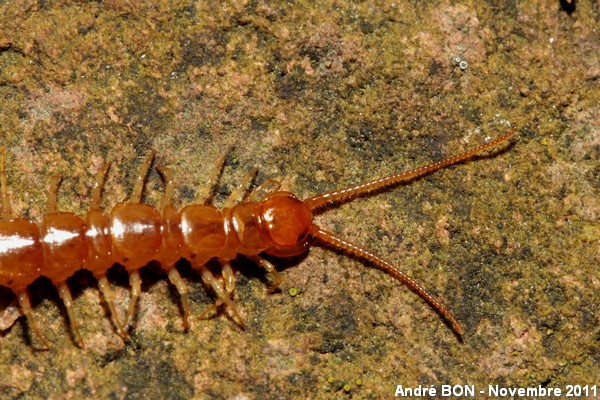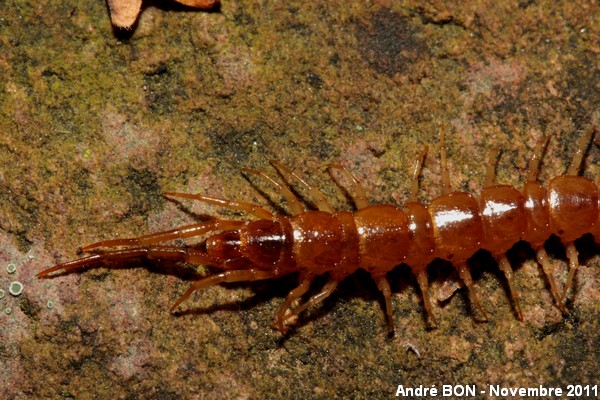



| Garden Centipede (Lithobius forficatus (Linnaeus, 1758)) |




|
|
Scientific name: Lithobius forficatus (Linnaeus, 1758) Common name: Garden Centipede French name: Lithobie à pinces Phylum: Arthropoda Class: Chilopoda Order: Lithobiomorpha Family: Lithobiidae Size: 18 to 30 mm. Habitat: Under stones, under tree bark or in the leaf litter in various habitats, forests, meadows, cultivated fields and near human buildings. You can find the Garden Centipede in rather dry places. Food: Sawbugs, small insects, spiders and other centipedes. They look for preys with their long tactile antennae. They immediately kill the preys with a bite using their venom claws (forcipules). Reproduction: In spring, the male deposits a spermatophore in a small web, it is then taken up by the female. The eggs are laid in the leaf litter. The larvae moult many times (13) to reach the adult stage. Their number of legs progressively increases during their first growing stages to reach 15 pairs. The Garden Centipede can live during several years. Geographic area: Europe, Island, Greenland, USA, Brazil, etc. |
You can clearly see the segments of the Garden Centipede's body, alternating one short segment and one long segment. There is one pair of legs on each segment for a total of 15 pairs. The body is reddish brown, the legs are paler and not ringed. The centipedes of the Scutigeromorpha order also show 15 pairs of legs but these ones are much longer compared to the legs of the centipedes of the Lithobiomorpha order like the Garden Centipede. The limits of the segments are also much less visible. The centipede's head is followed y a small segment bearing venom claws, the forcipules, which extend forwards on both side of the mouth. The Lithobiidae family is characterized by the presence of small spines on the different parts of the legs (you need very close-up pictures or an examination with binocular lenses to be able to see this). The Lithobius genus has a first pair of legs which is about the same size as the following ones (they are much larger on the Harpolithobius genus) and the last pair of legs is not so long (the length of the tibia of legs 15 is equal to or lower than the length of tergite 10. The last legs are much longer on the Eupolybothrus genus.) Telling the species apart requires to examine many details that are quite impossible to see on a picture shot in the field. Experts look at the number of articles on the antennae, the ocelli on the sides of the head, the teeth next to the forcipules, the presence and the location of spines on the legs, the presence of tooth-shaped extensions at the rear angles of some tergites, etc. Some simpler criteria, length of the body, ringed or uniform legs, habitat, region, enable to restrict the number of possible species. The Garden Centipede has tooth-shaped extensions on tergites 9, 11 and 13 (top view required), many ocelli (more than 20) on the side of the head, 4+4 or 5+5 teeth near the forcipules (view of the underside of the head required). The Garden Centipede, like other chilopoda, is a lucifugous species, meaning that it hides from the light. |
| [To know more about the Garden Centipede] [Next picture] [Top] |

|
As it is often the case, as soon as I think I have identified one species and then I try to dig in details, I realize that my conclusions were really too fast. The Lithobius genus is highly probable, but it is quite impossible to go further than Lithobius sp with this picture. |
| [To know more about the Garden Centipede] [Next picture] [Previous picture] [Top] |

|
I think that this centipede shows all the characteristics of the Lithobius genus. You can clearly see the spines on the legs and the tooth-shaped extensions on tergites 9, 11 and 13 on the non-reduced picture. |
| [To know more about the Garden Centipede] [Next picture] [Previous picture] [Top] |

|
Here is closer view on the head. The antennae have more than 30 articles (I have counted 39 articles on one antennae and 33 on the other one). The large size of the group of ocelli on the side of the head seems to indicate that there are a certain number of them. |
| [To know more about the Garden Centipede] [Previous picture] [Top] |

|
Here is a closer view on the rear part of the body. |